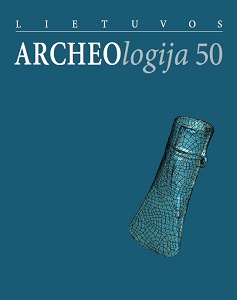PLYTŲ MOLIO MIŠINIŲ RECEPTŪROS: XIII–XIV A. VILNIAUS KATEDROS IR VILNIAUS ŽEMUTINĖS BEI LUCKO AUKŠTUTINĖS PILIŲ MŪRŲ GEOCHEMINIŲ TYRIMŲ ĮŽVALGOS
BRICK CLAY MIXTURE RECIPES: INSIGHTS FROM GEOCHEMICAL STUDIES OF THE 13TH–14TH CENTURY MASONRY OF THE VILNIUS CATHEDRAL, THE VILNIUS AND THE LUTSK CASTLES
Author(s): Saulius Sarcevičius, Rimantė Zinkutė, Petro Tronevich, Ričardas TaraškevičiusSubject(s): Christian Theology and Religion, Archaeology, Architecture, History of Church(es), 13th to 14th Centuries
Published by: Lietuvos istorijos institutas
Keywords: Geochemical archaeometry; X-ray fluorescence analysis; clustering dendrograms; development of brick production technologies; clay deposits;
Summary/Abstract: Bricks from three masonry objects of the Grand Duchy of Lithuania (GDL) are compared. Two of them represent Vilnius, its early Cathedral and the Lower Castle, the third one – the defensive fortifications of the Lutsk Castle in Ukraine. The beginning of their construction is probably separated by the period of 65–135 years. Each object is characterized by five bricks. In each of them, the contents of 15 analytes – Al, Ba, Ca, Fe, Ga, K, Mg, Nb, P, Rb, Si, Sr, Th, Ti, and Zr are determined using energy dispersive X-ray fluorescence. The aim of their analysis is comparison of geochemical composition of clay mixtures used for production of masonry bricks in order to estimate the links and differences of production technologies. For this, various mathematical statistical methods were used including cluster analysis which enabled to find out not only typical bricks, but also outliers of masonry objects. The links between mineralogical and geochemical data and their informative potential are discussed in detail. The contents of Al, Ca, Mg and Si in Vilnius bricks and the values of their ratios (Si/Al, Ca/Al, (Ca,Mg)/Al) are compared with the corresponding values in 70 samples from 17 adjacent clay layers of deposits. It is hypothesized that in the period of the second half of the 13th century – 14th century, the bricklayers in the Grand Duchy of Lithuania developed their techniques by changing the clay mixture recipes. Starting with lower in calcium clays, they became proficient in using Ca (Mg, Sr) rich clays as well, which enabled the acceptability of most clays in the surroundings. Poorer Ca (Sr, Mg) clays were used for the Cathedral, and richer clays for the production of bricks for Vilnius and Lutsk castles. Lower in Ca and Sr contents clays were used for the Cathedral, and higher in these analytes clays for the production of bricks for Vilnius and Lutsk castles.
Journal: Lietuvos archeologija
- Issue Year: 2024
- Issue No: 50
- Page Range: 153-207
- Page Count: 55
- Language: Lithuanian

